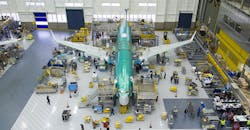A “couple of dozen” Federal Aviation Administration inspectors are in place at Boeing’s 737 MAX assembly plant in Renton, Wash., visually inspecting the work there to identify any causes of the in-flight incident aboard an Alaska Airlines 737 MAX 9 jet on January 5, and in line with the agency’s statement earlier this week. The agency’s administrator Mike Whitaker in a broadcast interview said the inspectors are “shifting from more of an audit approach to a direct inspection approach.”
Whitaker said the inspectors will remain in place at Boeing until the FAA is comfortable with the quality assurance program there.
Beyond the inspections, the FAA is blocking Boeing’s long-scheduled increase in the 737 MAX production rate from 37 to 50 jets/month. “We will not agree to any request from Boeing for an expansion in production or approve additional production lines for the 737 MAX until we are satisfied that the quality-control issues uncovered during this process are resolved,” Whitaker said in a statement.
In addition to the FAA inspectors, National Transportation Safety Board investigators are examining production records of the Alaska Airlines jet, which had been delivered from Boeing in October.
In the January 5 incident, an Alaska Airlines flight from Portland, Ore., to Ontario, Calif., experienced an in-flight emergency shortly after takeoff when a mid-exit panel (or “plug”) in the cabin was blown open, depressurizing the aircraft. The jet returned to Portland and landed safely with all 171 passengers and six crew members.
The FAA immediately grounded more than 170 Boeing 737 MAX 9 jets pending inspections of the mid-exit panels – a structure that is assembled into place and sealed during aircraft assembly to fill the space of an optional side door that some operators may choose.
On January 21, FAA expanded the scope of its instructions to operators of an earlier-generation jet, the 737-900ER, which has a comparable panel placement.
Mid-exit door plugs are panels installed to seal the passenger cabin in the place of an optional exit designed for the aircraft.
Whitaker would not offer a projection on the length of time it may take to inspect all the aircraft in service, which remain grounded for carriers like Alaska Airlines and United Airlines. At first the FAA stated that each inspection would take up to eight hours, but the administrator now explained that is no longer accurate.
“We’ve required a lot of measurements,” he told a CNCB interviewer. “Once the area’s exposed, we want to understand bolt tensions and gaps and things of that nature. So we’ve required more data than would normally be the case because we really wanted to understand the issue.”
Boeing continues to cooperate with the investigation. Boeing Commercial Airplanes CEO Stan Deal state earlier this week that the manufacturer will halt production on several lines this week to assess safety-oriented measures now in place and find ways to improve them.
“We are taking action on a comprehensive plan to bring these airplanes safely back to service and to improve our quality and delivery performance,” according to a statement by Deal, adding:
“We will follow the lead of the FAA and support our customers every step of the way.”
